Benefits Manager Resume Examples

Jul 18, 2024
|
12 min read
Crafting a winning benefits manager resume: the keys to unlocking your career potential.
Rated by 348 people
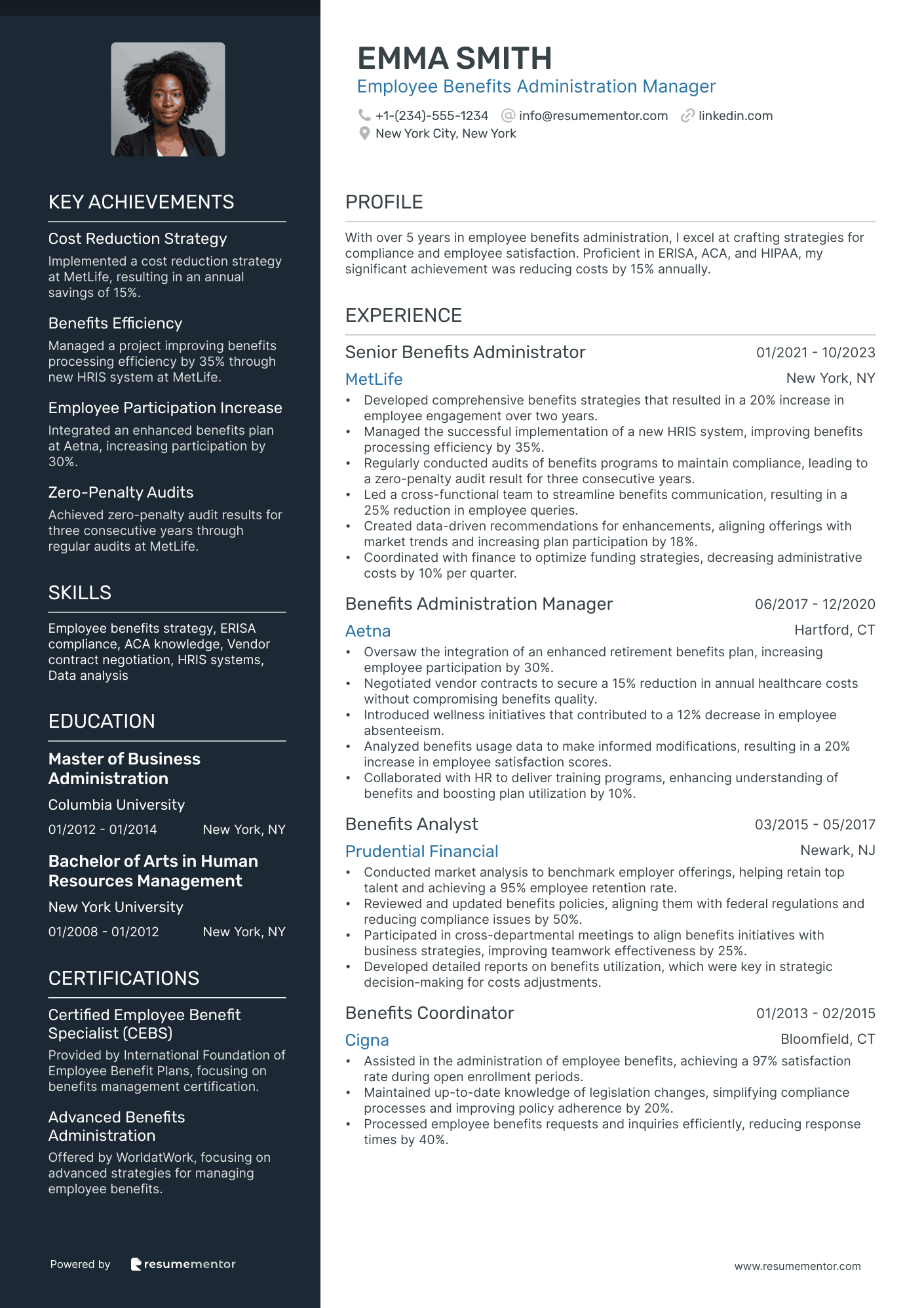
Employee Benefits Administration Manager
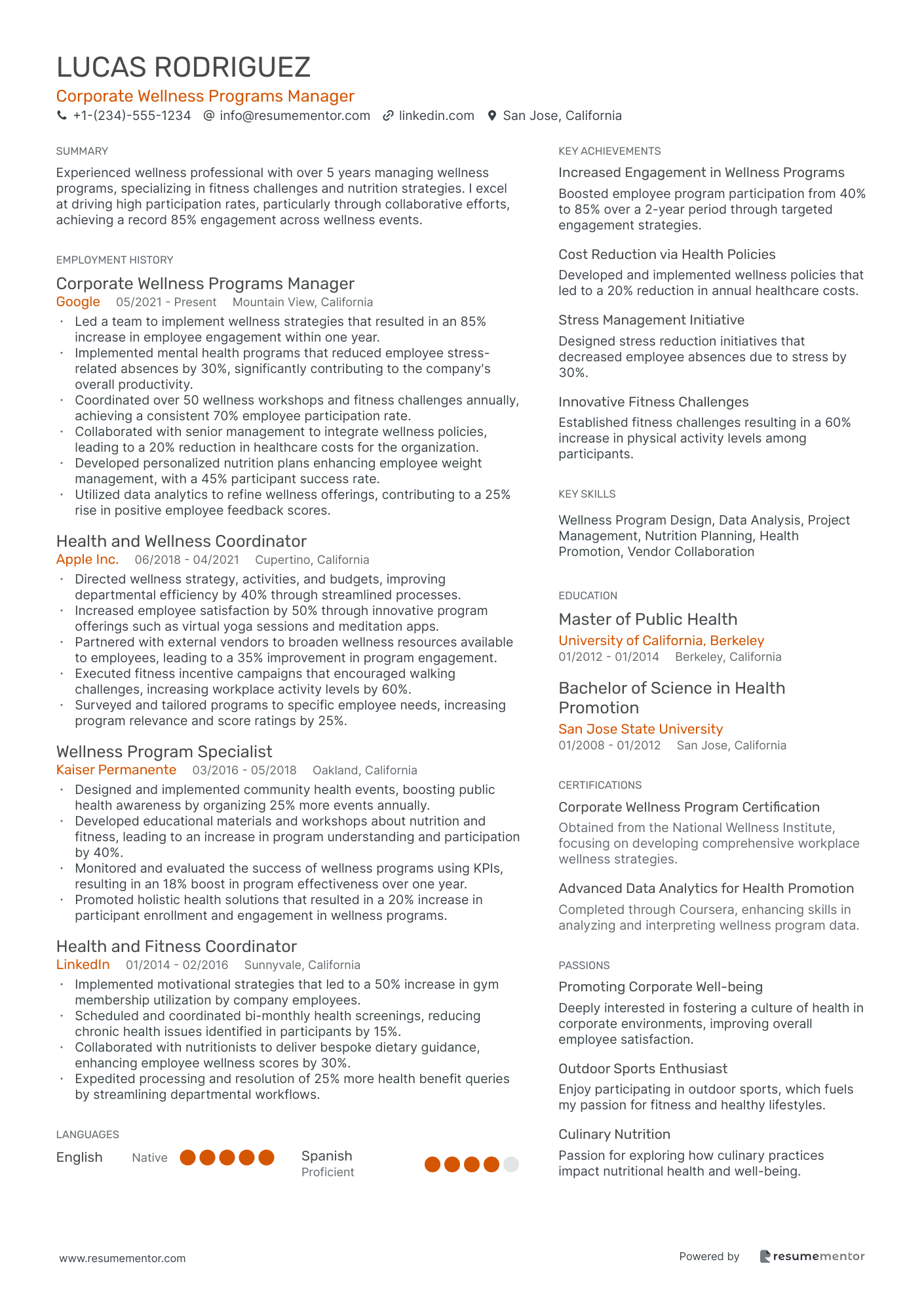
Corporate Wellness Programs Manager
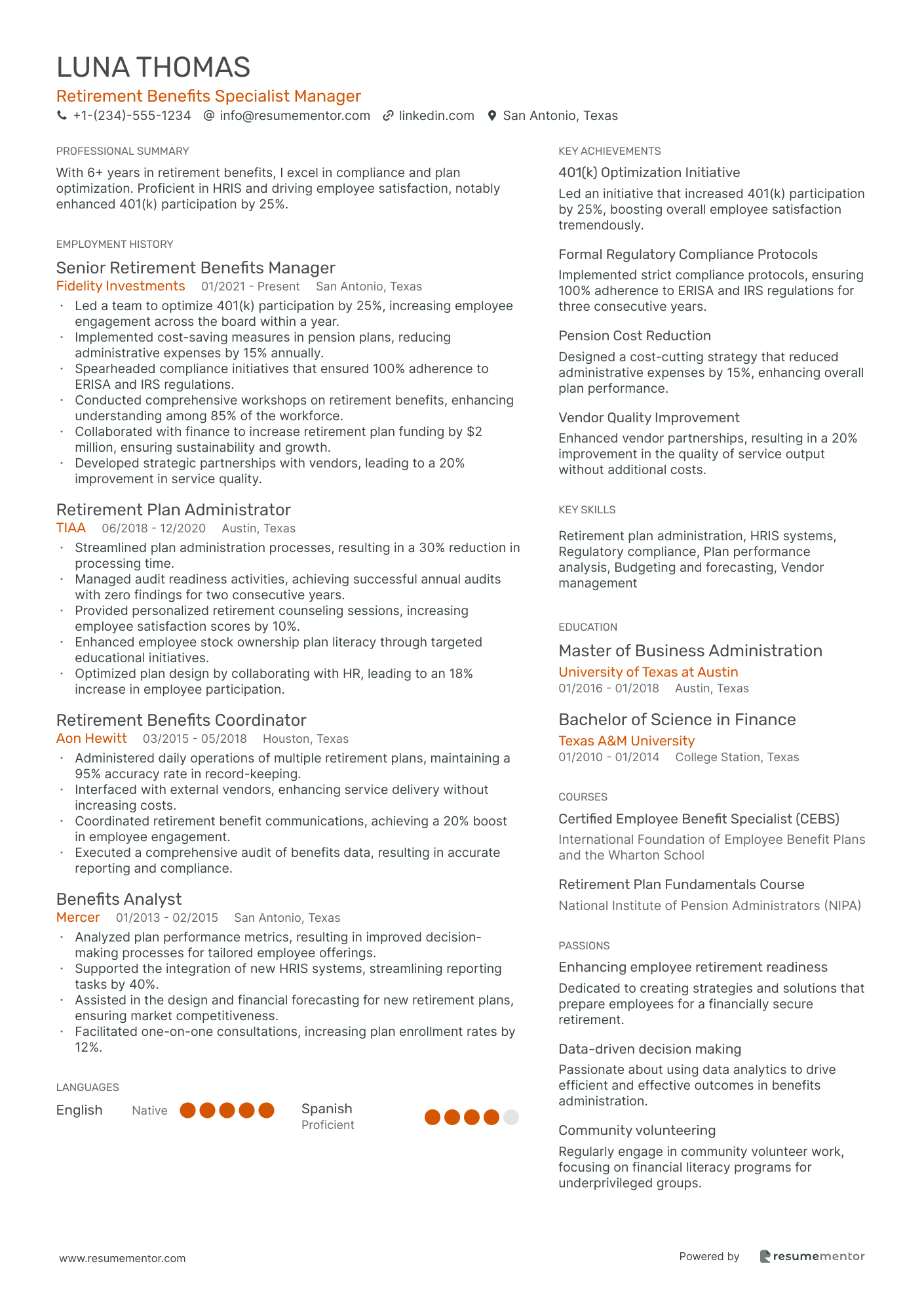
Retirement Benefits Specialist Manager
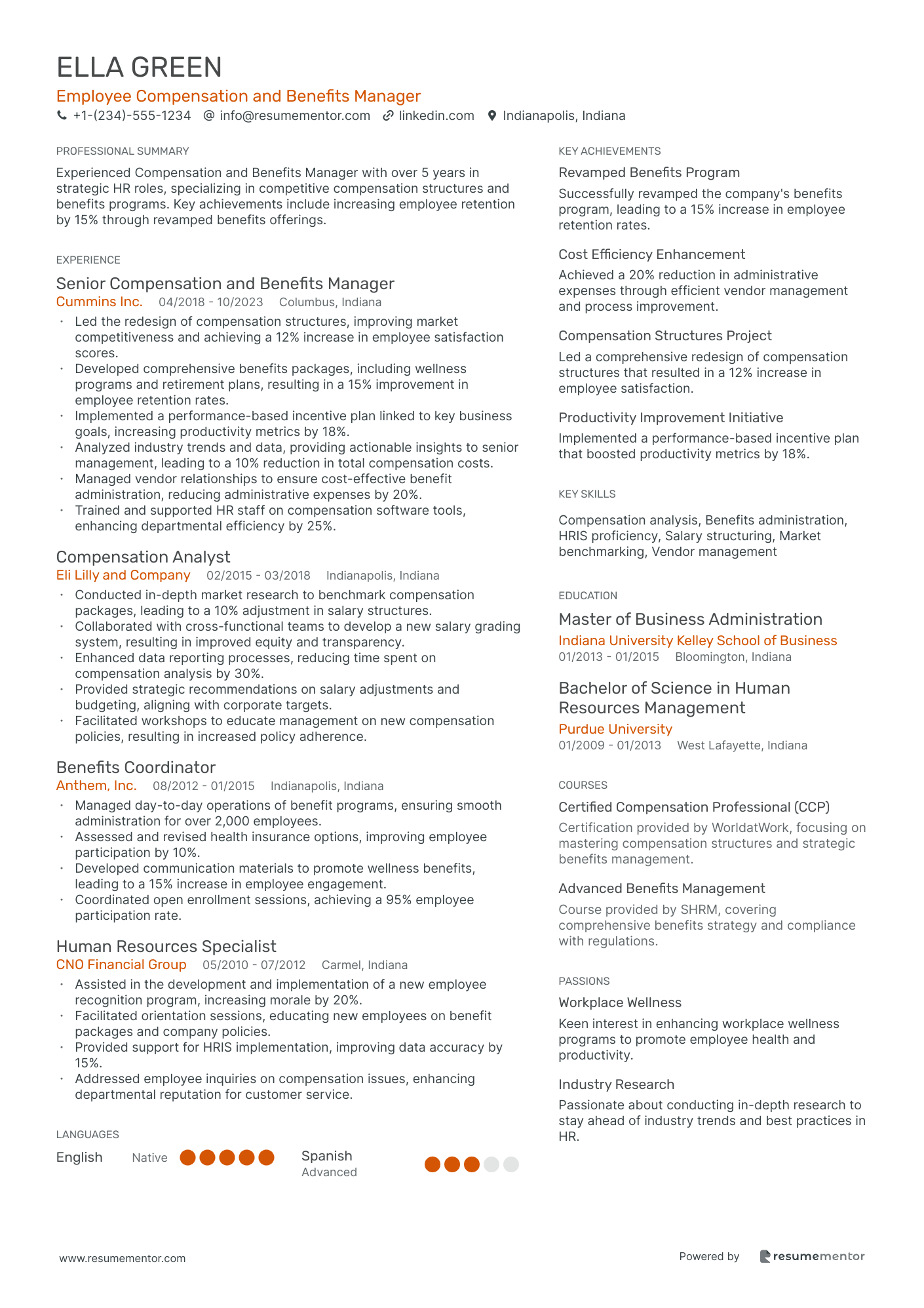
Employee Compensation and Benefits Manager
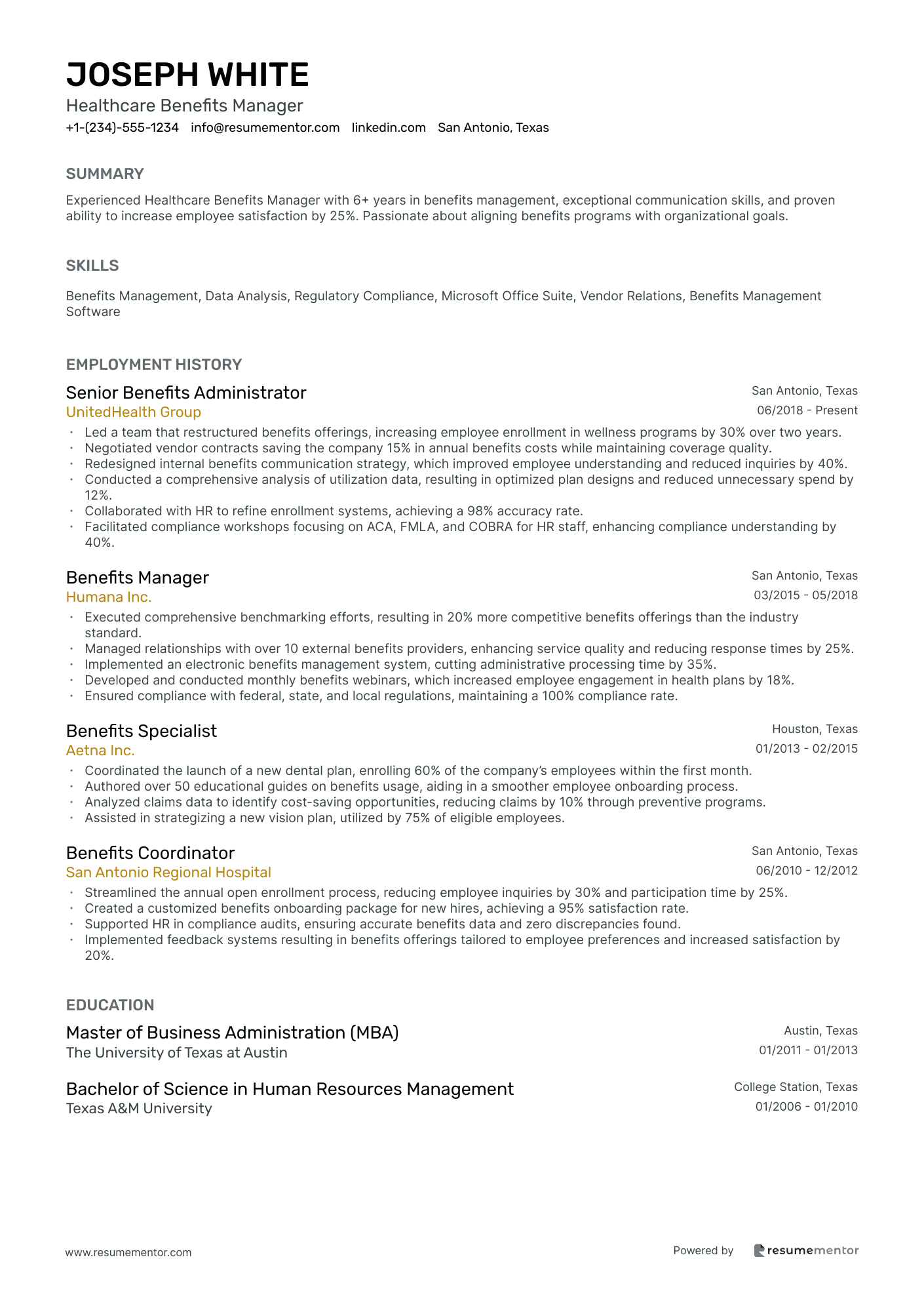
Healthcare Benefits Manager
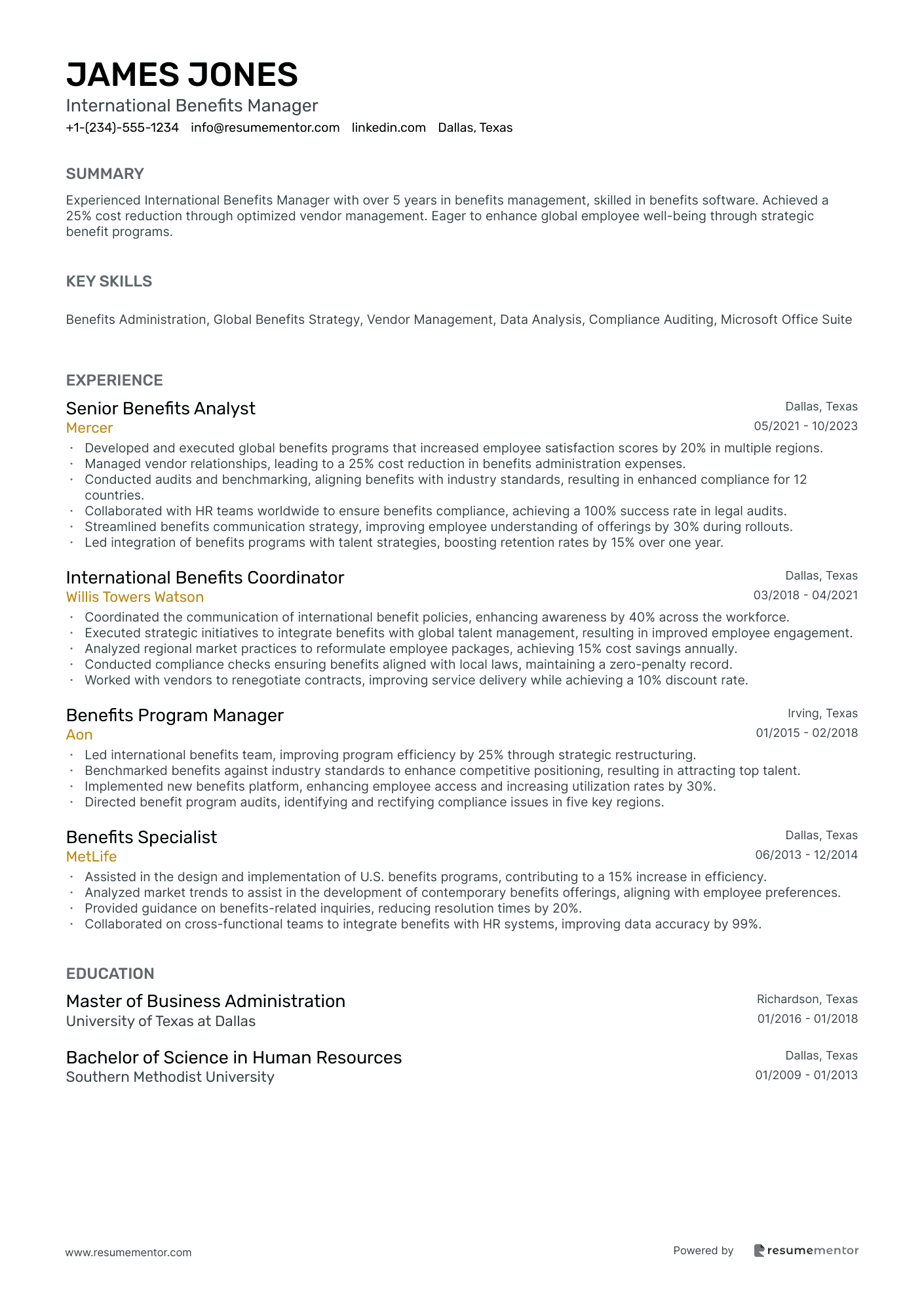
International Benefits Manager
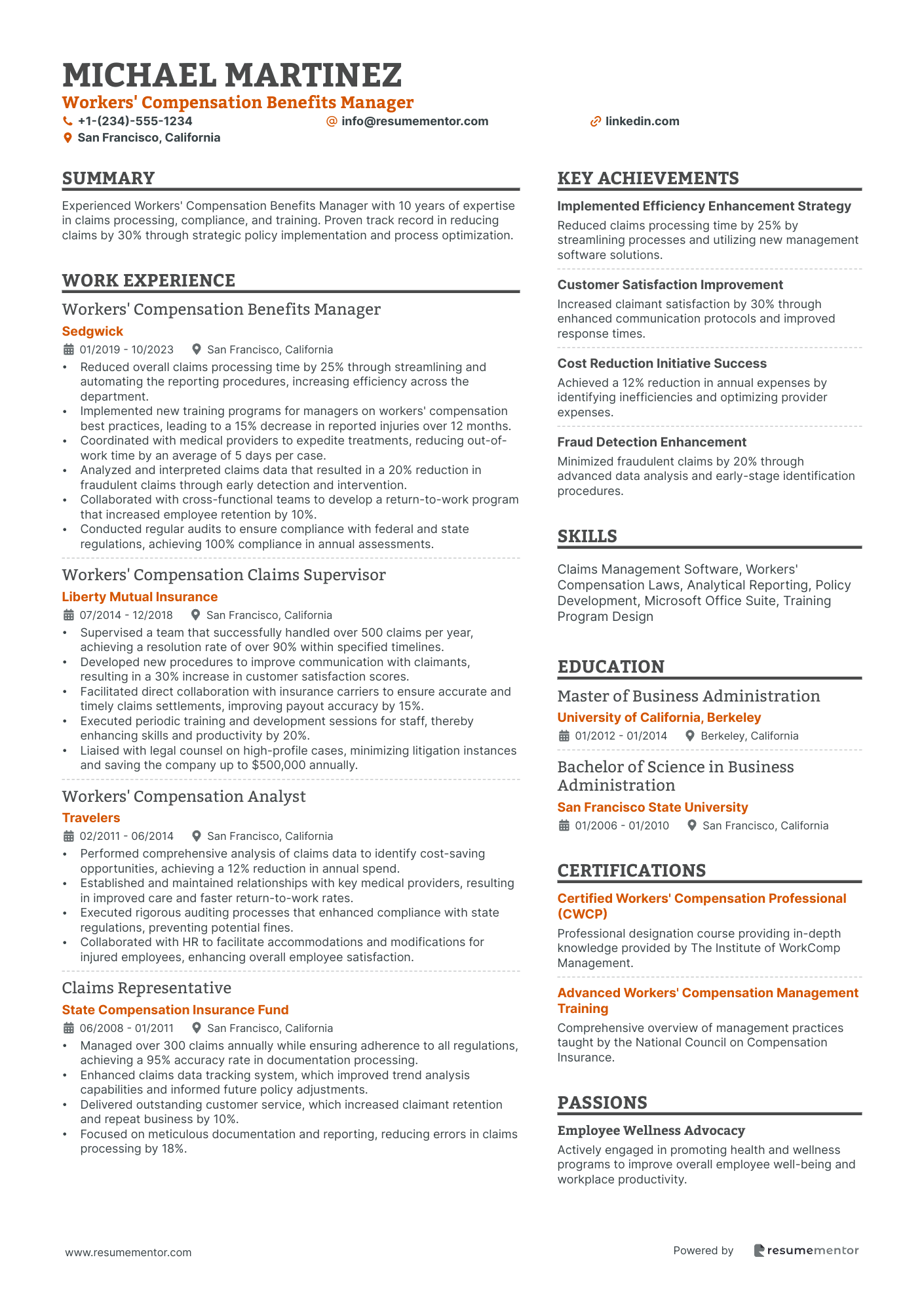
Workers' Compensation Benefits Manager
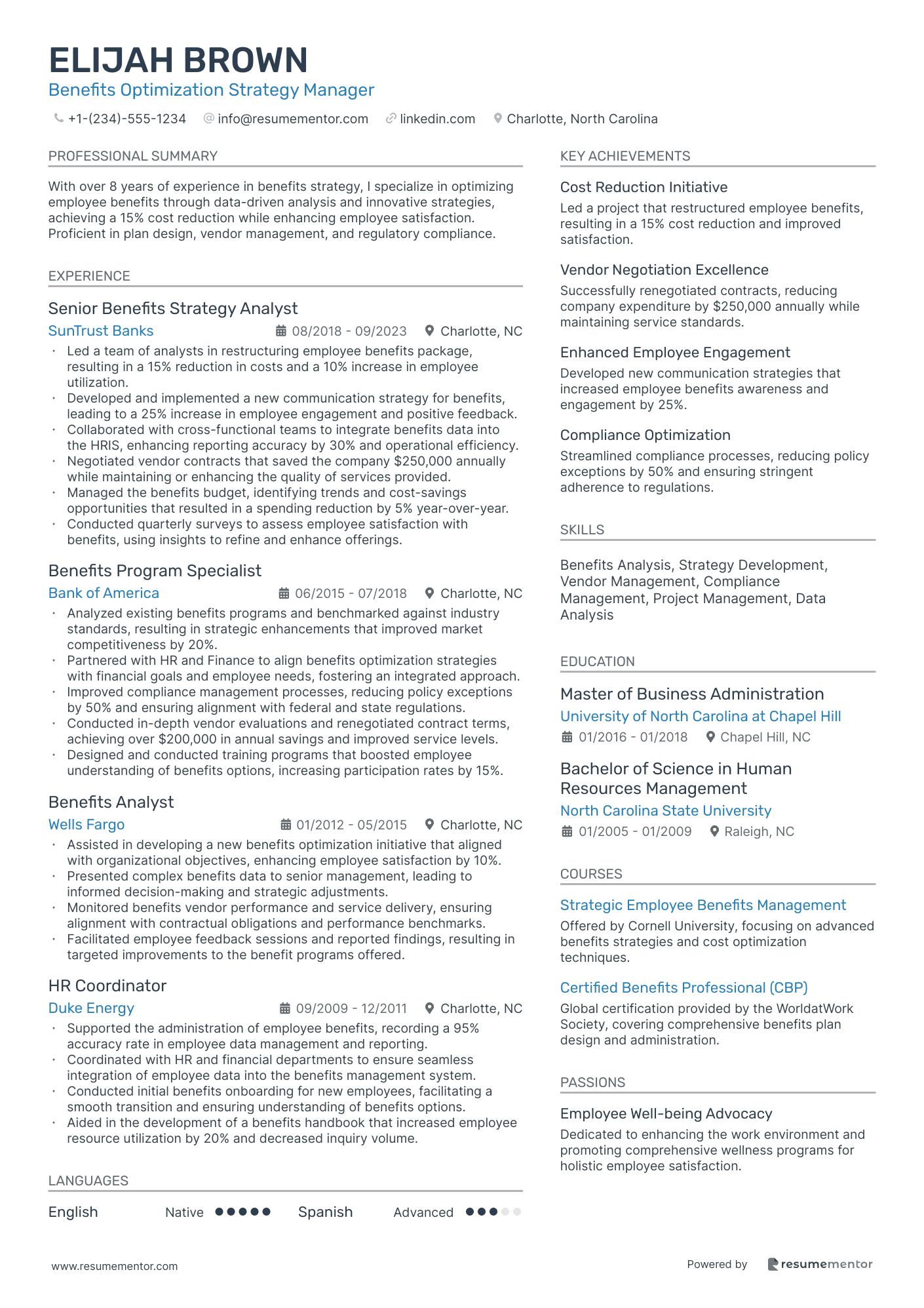
Benefits Optimization Strategy Manager
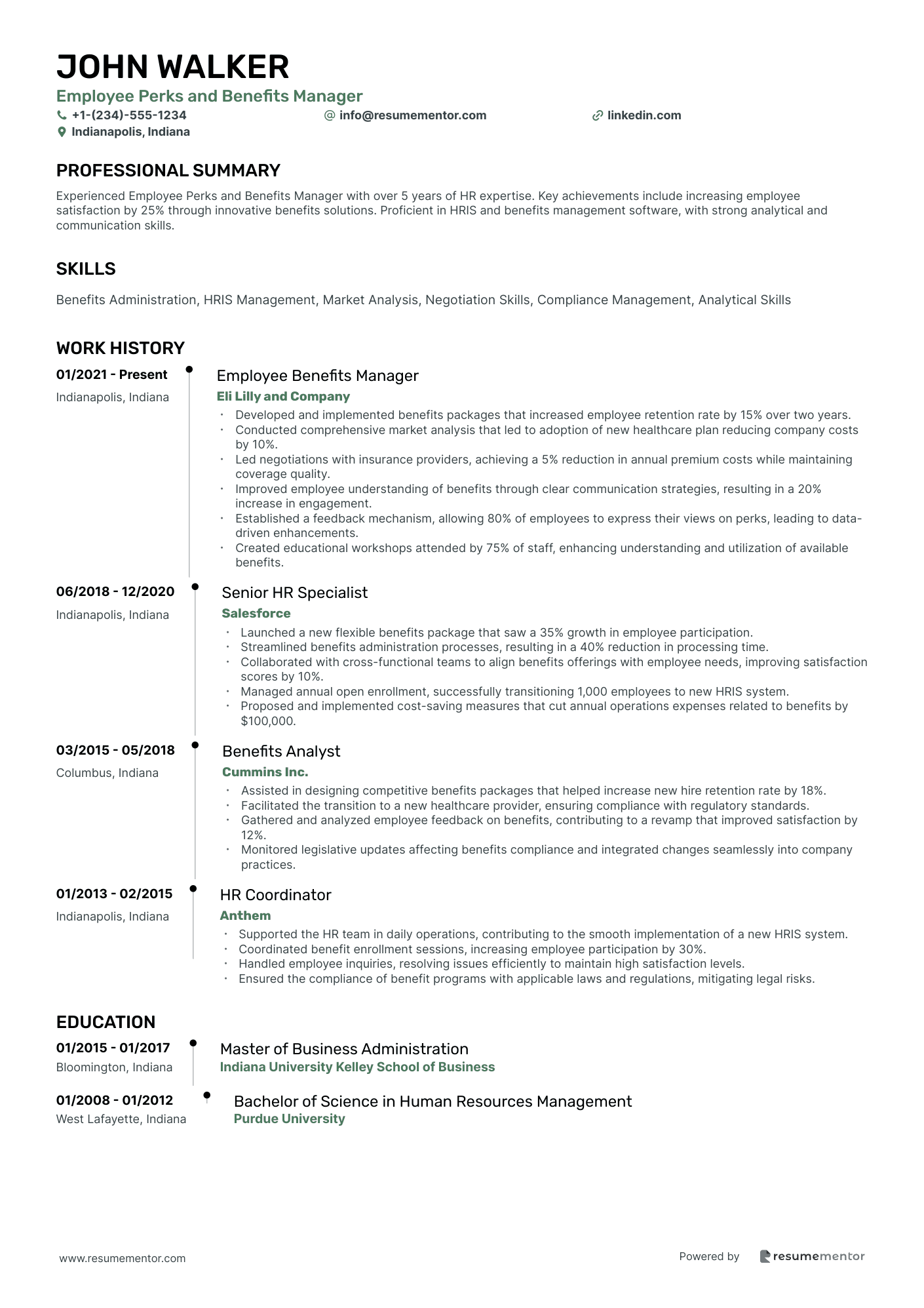
Employee Perks and Benefits Manager
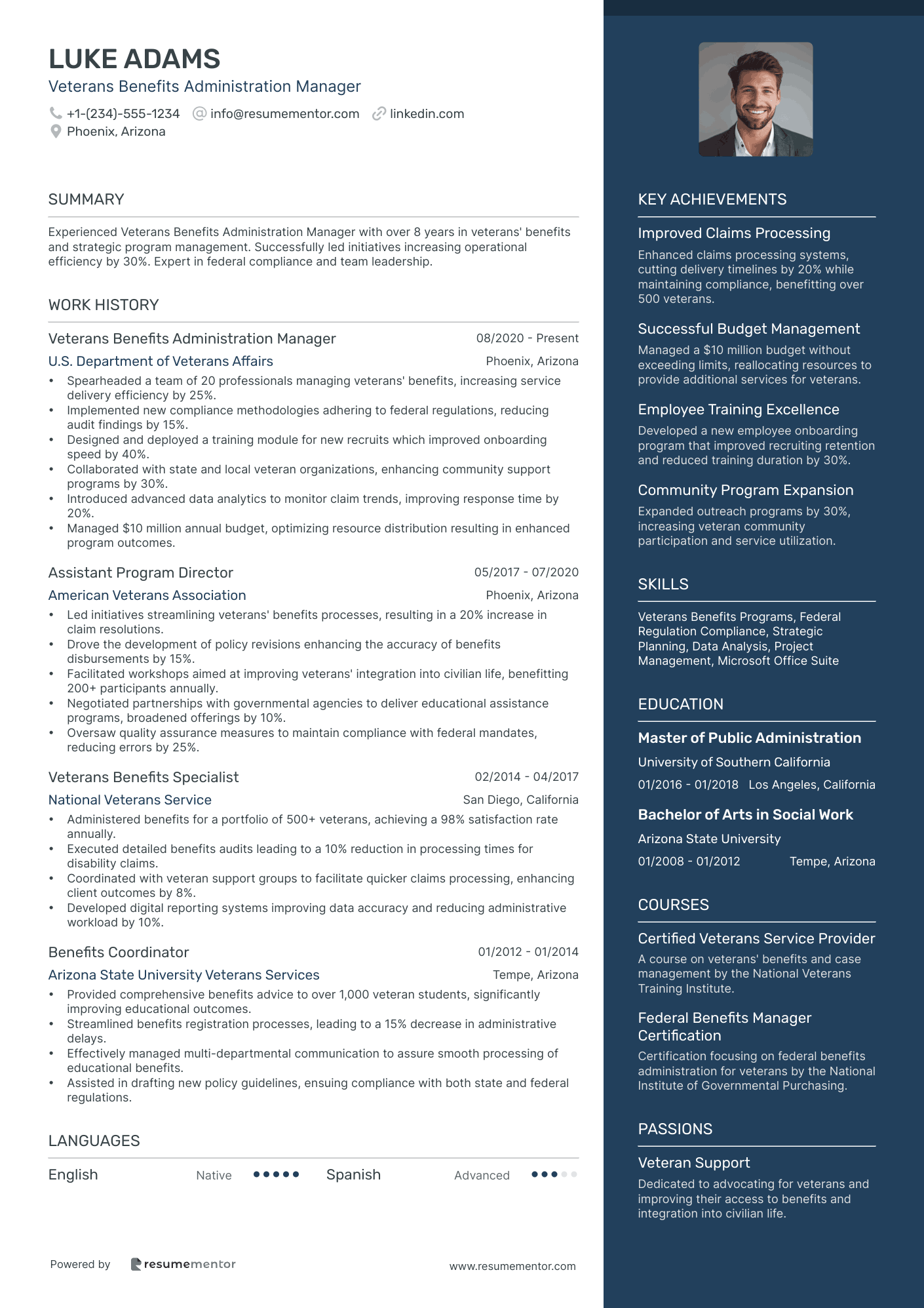
Veterans Benefits Administration Manager

Employee Benefits Administration Manager resume sample
- •Developed comprehensive benefits strategies that resulted in a 20% increase in employee engagement over two years.
- •Managed the successful implementation of a new HRIS system, improving benefits processing efficiency by 35%.
- •Regularly conducted audits of benefits programs to maintain compliance, leading to a zero-penalty audit result for three consecutive years.
- •Led a cross-functional team to streamline benefits communication, resulting in a 25% reduction in employee queries.
- •Created data-driven recommendations for enhancements, aligning offerings with market trends and increasing plan participation by 18%.
- •Coordinated with finance to optimize funding strategies, decreasing administrative costs by 10% per quarter.
- •Oversaw the integration of an enhanced retirement benefits plan, increasing employee participation by 30%.
- •Negotiated vendor contracts to secure a 15% reduction in annual healthcare costs without compromising benefits quality.
- •Introduced wellness initiatives that contributed to a 12% decrease in employee absenteeism.
- •Analyzed benefits usage data to make informed modifications, resulting in a 20% increase in employee satisfaction scores.
- •Collaborated with HR to deliver training programs, enhancing understanding of benefits and boosting plan utilization by 10%.
- •Conducted market analysis to benchmark employer offerings, helping retain top talent and achieving a 95% employee retention rate.
- •Reviewed and updated benefits policies, aligning them with federal regulations and reducing compliance issues by 50%.
- •Participated in cross-departmental meetings to align benefits initiatives with business strategies, improving teamwork effectiveness by 25%.
- •Developed detailed reports on benefits utilization, which were key in strategic decision-making for costs adjustments.
- •Assisted in the administration of employee benefits, achieving a 97% satisfaction rate during open enrollment periods.
- •Maintained up-to-date knowledge of legislation changes, simplifying compliance processes and improving policy adherence by 20%.
- •Processed employee benefits requests and inquiries efficiently, reducing response times by 40%.
Corporate Wellness Programs Manager resume sample
- •Led a team to implement wellness strategies that resulted in an 85% increase in employee engagement within one year.
- •Implemented mental health programs that reduced employee stress-related absences by 30%, significantly contributing to the company's overall productivity.
- •Coordinated over 50 wellness workshops and fitness challenges annually, achieving a consistent 70% employee participation rate.
- •Collaborated with senior management to integrate wellness policies, leading to a 20% reduction in healthcare costs for the organization.
- •Developed personalized nutrition plans enhancing employee weight management, with a 45% participant success rate.
- •Utilized data analytics to refine wellness offerings, contributing to a 25% rise in positive employee feedback scores.
- •Directed wellness strategy, activities, and budgets, improving departmental efficiency by 40% through streamlined processes.
- •Increased employee satisfaction by 50% through innovative program offerings such as virtual yoga sessions and meditation apps.
- •Partnered with external vendors to broaden wellness resources available to employees, leading to a 35% improvement in program engagement.
- •Executed fitness incentive campaigns that encouraged walking challenges, increasing workplace activity levels by 60%.
- •Surveyed and tailored programs to specific employee needs, increasing program relevance and score ratings by 25%.
- •Designed and implemented community health events, boosting public health awareness by organizing 25% more events annually.
- •Developed educational materials and workshops about nutrition and fitness, leading to an increase in program understanding and participation by 40%.
- •Monitored and evaluated the success of wellness programs using KPIs, resulting in an 18% boost in program effectiveness over one year.
- •Promoted holistic health solutions that resulted in a 20% increase in participant enrollment and engagement in wellness programs.
- •Implemented motivational strategies that led to a 50% increase in gym membership utilization by company employees.
- •Scheduled and coordinated bi-monthly health screenings, reducing chronic health issues identified in participants by 15%.
- •Collaborated with nutritionists to deliver bespoke dietary guidance, enhancing employee wellness scores by 30%.
- •Expedited processing and resolution of 25% more health benefit queries by streamlining departmental workflows.
Retirement Benefits Specialist Manager resume sample
- •Led a team to optimize 401(k) participation by 25%, increasing employee engagement across the board within a year.
- •Implemented cost-saving measures in pension plans, reducing administrative expenses by 15% annually.
- •Spearheaded compliance initiatives that ensured 100% adherence to ERISA and IRS regulations.
- •Conducted comprehensive workshops on retirement benefits, enhancing understanding among 85% of the workforce.
- •Collaborated with finance to increase retirement plan funding by $2 million, ensuring sustainability and growth.
- •Developed strategic partnerships with vendors, leading to a 20% improvement in service quality.
- •Streamlined plan administration processes, resulting in a 30% reduction in processing time.
- •Managed audit readiness activities, achieving successful annual audits with zero findings for two consecutive years.
- •Provided personalized retirement counseling sessions, increasing employee satisfaction scores by 10%.
- •Enhanced employee stock ownership plan literacy through targeted educational initiatives.
- •Optimized plan design by collaborating with HR, leading to an 18% increase in employee participation.
- •Administered daily operations of multiple retirement plans, maintaining a 95% accuracy rate in record-keeping.
- •Interfaced with external vendors, enhancing service delivery without increasing costs.
- •Coordinated retirement benefit communications, achieving a 20% boost in employee engagement.
- •Executed a comprehensive audit of benefits data, resulting in accurate reporting and compliance.
- •Analyzed plan performance metrics, resulting in improved decision-making processes for tailored employee offerings.
- •Supported the integration of new HRIS systems, streamlining reporting tasks by 40%.
- •Assisted in the design and financial forecasting for new retirement plans, ensuring market competitiveness.
- •Facilitated one-on-one consultations, increasing plan enrollment rates by 12%.
Employee Compensation and Benefits Manager resume sample
- •Led the redesign of compensation structures, improving market competitiveness and achieving a 12% increase in employee satisfaction scores.
- •Developed comprehensive benefits packages, including wellness programs and retirement plans, resulting in a 15% improvement in employee retention rates.
- •Implemented a performance-based incentive plan linked to key business goals, increasing productivity metrics by 18%.
- •Analyzed industry trends and data, providing actionable insights to senior management, leading to a 10% reduction in total compensation costs.
- •Managed vendor relationships to ensure cost-effective benefit administration, reducing administrative expenses by 20%.
- •Trained and supported HR staff on compensation software tools, enhancing departmental efficiency by 25%.
- •Conducted in-depth market research to benchmark compensation packages, leading to a 10% adjustment in salary structures.
- •Collaborated with cross-functional teams to develop a new salary grading system, resulting in improved equity and transparency.
- •Enhanced data reporting processes, reducing time spent on compensation analysis by 30%.
- •Provided strategic recommendations on salary adjustments and budgeting, aligning with corporate targets.
- •Facilitated workshops to educate management on new compensation policies, resulting in increased policy adherence.
- •Managed day-to-day operations of benefit programs, ensuring smooth administration for over 2,000 employees.
- •Assessed and revised health insurance options, improving employee participation by 10%.
- •Developed communication materials to promote wellness benefits, leading to a 15% increase in employee engagement.
- •Coordinated open enrollment sessions, achieving a 95% employee participation rate.
- •Assisted in the development and implementation of a new employee recognition program, increasing morale by 20%.
- •Facilitated orientation sessions, educating new employees on benefit packages and company policies.
- •Provided support for HRIS implementation, improving data accuracy by 15%.
- •Addressed employee inquiries on compensation issues, enhancing departmental reputation for customer service.
Healthcare Benefits Manager resume sample
- •Led a team that restructured benefits offerings, increasing employee enrollment in wellness programs by 30% over two years.
- •Negotiated vendor contracts saving the company 15% in annual benefits costs while maintaining coverage quality.
- •Redesigned internal benefits communication strategy, which improved employee understanding and reduced inquiries by 40%.
- •Conducted a comprehensive analysis of utilization data, resulting in optimized plan designs and reduced unnecessary spend by 12%.
- •Collaborated with HR to refine enrollment systems, achieving a 98% accuracy rate.
- •Facilitated compliance workshops focusing on ACA, FMLA, and COBRA for HR staff, enhancing compliance understanding by 40%.
- •Executed comprehensive benchmarking efforts, resulting in 20% more competitive benefits offerings than the industry standard.
- •Managed relationships with over 10 external benefits providers, enhancing service quality and reducing response times by 25%.
- •Implemented an electronic benefits management system, cutting administrative processing time by 35%.
- •Developed and conducted monthly benefits webinars, which increased employee engagement in health plans by 18%.
- •Ensured compliance with federal, state, and local regulations, maintaining a 100% compliance rate.
- •Coordinated the launch of a new dental plan, enrolling 60% of the company’s employees within the first month.
- •Authored over 50 educational guides on benefits usage, aiding in a smoother employee onboarding process.
- •Analyzed claims data to identify cost-saving opportunities, reducing claims by 10% through preventive programs.
- •Assisted in strategizing a new vision plan, utilized by 75% of eligible employees.
- •Streamlined the annual open enrollment process, reducing employee inquiries by 30% and participation time by 25%.
- •Created a customized benefits onboarding package for new hires, achieving a 95% satisfaction rate.
- •Supported HR in compliance audits, ensuring accurate benefits data and zero discrepancies found.
- •Implemented feedback systems resulting in benefits offerings tailored to employee preferences and increased satisfaction by 20%.
International Benefits Manager resume sample
- •Developed and executed global benefits programs that increased employee satisfaction scores by 20% in multiple regions.
- •Managed vendor relationships, leading to a 25% cost reduction in benefits administration expenses.
- •Conducted audits and benchmarking, aligning benefits with industry standards, resulting in enhanced compliance for 12 countries.
- •Collaborated with HR teams worldwide to ensure benefits compliance, achieving a 100% success rate in legal audits.
- •Streamlined benefits communication strategy, improving employee understanding of offerings by 30% during rollouts.
- •Led integration of benefits programs with talent strategies, boosting retention rates by 15% over one year.
- •Coordinated the communication of international benefit policies, enhancing awareness by 40% across the workforce.
- •Executed strategic initiatives to integrate benefits with global talent management, resulting in improved employee engagement.
- •Analyzed regional market practices to reformulate employee packages, achieving 15% cost savings annually.
- •Conducted compliance checks ensuring benefits aligned with local laws, maintaining a zero-penalty record.
- •Worked with vendors to renegotiate contracts, improving service delivery while achieving a 10% discount rate.
- •Led international benefits team, improving program efficiency by 25% through strategic restructuring.
- •Benchmarked benefits against industry standards to enhance competitive positioning, resulting in attracting top talent.
- •Implemented new benefits platform, enhancing employee access and increasing utilization rates by 30%.
- •Directed benefit program audits, identifying and rectifying compliance issues in five key regions.
- •Assisted in the design and implementation of U.S. benefits programs, contributing to a 15% increase in efficiency.
- •Analyzed market trends to assist in the development of contemporary benefits offerings, aligning with employee preferences.
- •Provided guidance on benefits-related inquiries, reducing resolution times by 20%.
- •Collaborated on cross-functional teams to integrate benefits with HR systems, improving data accuracy by 99%.
Workers' Compensation Benefits Manager resume sample
- •Reduced overall claims processing time by 25% through streamlining and automating the reporting procedures, increasing efficiency across the department.
- •Implemented new training programs for managers on workers' compensation best practices, leading to a 15% decrease in reported injuries over 12 months.
- •Coordinated with medical providers to expedite treatments, reducing out-of-work time by an average of 5 days per case.
- •Analyzed and interpreted claims data that resulted in a 20% reduction in fraudulent claims through early detection and intervention.
- •Collaborated with cross-functional teams to develop a return-to-work program that increased employee retention by 10%.
- •Conducted regular audits to ensure compliance with federal and state regulations, achieving 100% compliance in annual assessments.
- •Supervised a team that successfully handled over 500 claims per year, achieving a resolution rate of over 90% within specified timelines.
- •Developed new procedures to improve communication with claimants, resulting in a 30% increase in customer satisfaction scores.
- •Facilitated direct collaboration with insurance carriers to ensure accurate and timely claims settlements, improving payout accuracy by 15%.
- •Executed periodic training and development sessions for staff, thereby enhancing skills and productivity by 20%.
- •Liaised with legal counsel on high-profile cases, minimizing litigation instances and saving the company up to $500,000 annually.
- •Performed comprehensive analysis of claims data to identify cost-saving opportunities, achieving a 12% reduction in annual spend.
- •Established and maintained relationships with key medical providers, resulting in improved care and faster return-to-work rates.
- •Executed rigorous auditing processes that enhanced compliance with state regulations, preventing potential fines.
- •Collaborated with HR to facilitate accommodations and modifications for injured employees, enhancing overall employee satisfaction.
- •Managed over 300 claims annually while ensuring adherence to all regulations, achieving a 95% accuracy rate in documentation processing.
- •Enhanced claims data tracking system, which improved trend analysis capabilities and informed future policy adjustments.
- •Delivered outstanding customer service, which increased claimant retention and repeat business by 10%.
- •Focused on meticulous documentation and reporting, reducing errors in claims processing by 18%.
Benefits Optimization Strategy Manager resume sample
- •Led a team of analysts in restructuring employee benefits package, resulting in a 15% reduction in costs and a 10% increase in employee utilization.
- •Developed and implemented a new communication strategy for benefits, leading to a 25% increase in employee engagement and positive feedback.
- •Collaborated with cross-functional teams to integrate benefits data into the HRIS, enhancing reporting accuracy by 30% and operational efficiency.
- •Negotiated vendor contracts that saved the company $250,000 annually while maintaining or enhancing the quality of services provided.
- •Managed the benefits budget, identifying trends and cost-savings opportunities that resulted in a spending reduction by 5% year-over-year.
- •Conducted quarterly surveys to assess employee satisfaction with benefits, using insights to refine and enhance offerings.
- •Analyzed existing benefits programs and benchmarked against industry standards, resulting in strategic enhancements that improved market competitiveness by 20%.
- •Partnered with HR and Finance to align benefits optimization strategies with financial goals and employee needs, fostering an integrated approach.
- •Improved compliance management processes, reducing policy exceptions by 50% and ensuring alignment with federal and state regulations.
- •Conducted in-depth vendor evaluations and renegotiated contract terms, achieving over $200,000 in annual savings and improved service levels.
- •Designed and conducted training programs that boosted employee understanding of benefits options, increasing participation rates by 15%.
- •Assisted in developing a new benefits optimization initiative that aligned with organizational objectives, enhancing employee satisfaction by 10%.
- •Presented complex benefits data to senior management, leading to informed decision-making and strategic adjustments.
- •Monitored benefits vendor performance and service delivery, ensuring alignment with contractual obligations and performance benchmarks.
- •Facilitated employee feedback sessions and reported findings, resulting in targeted improvements to the benefit programs offered.
- •Supported the administration of employee benefits, recording a 95% accuracy rate in employee data management and reporting.
- •Coordinated with HR and financial departments to ensure seamless integration of employee data into the benefits management system.
- •Conducted initial benefits onboarding for new employees, facilitating a smooth transition and ensuring understanding of benefits options.
- •Aided in the development of a benefits handbook that increased employee resource utilization by 20% and decreased inquiry volume.
Employee Perks and Benefits Manager resume sample
- •Developed and implemented benefits packages that increased employee retention rate by 15% over two years.
- •Conducted comprehensive market analysis that led to adoption of new healthcare plan reducing company costs by 10%.
- •Led negotiations with insurance providers, achieving a 5% reduction in annual premium costs while maintaining coverage quality.
- •Improved employee understanding of benefits through clear communication strategies, resulting in a 20% increase in engagement.
- •Established a feedback mechanism, allowing 80% of employees to express their views on perks, leading to data-driven enhancements.
- •Created educational workshops attended by 75% of staff, enhancing understanding and utilization of available benefits.
- •Launched a new flexible benefits package that saw a 35% growth in employee participation.
- •Streamlined benefits administration processes, resulting in a 40% reduction in processing time.
- •Collaborated with cross-functional teams to align benefits offerings with employee needs, improving satisfaction scores by 10%.
- •Managed annual open enrollment, successfully transitioning 1,000 employees to new HRIS system.
- •Proposed and implemented cost-saving measures that cut annual operations expenses related to benefits by $100,000.
- •Assisted in designing competitive benefits packages that helped increase new hire retention rate by 18%.
- •Facilitated the transition to a new healthcare provider, ensuring compliance with regulatory standards.
- •Gathered and analyzed employee feedback on benefits, contributing to a revamp that improved satisfaction by 12%.
- •Monitored legislative updates affecting benefits compliance and integrated changes seamlessly into company practices.
- •Supported the HR team in daily operations, contributing to the smooth implementation of a new HRIS system.
- •Coordinated benefit enrollment sessions, increasing employee participation by 30%.
- •Handled employee inquiries, resolving issues efficiently to maintain high satisfaction levels.
- •Ensured the compliance of benefit programs with applicable laws and regulations, mitigating legal risks.
Veterans Benefits Administration Manager resume sample
- •Spearheaded a team of 20 professionals managing veterans' benefits, increasing service delivery efficiency by 25%.
- •Implemented new compliance methodologies adhering to federal regulations, reducing audit findings by 15%.
- •Designed and deployed a training module for new recruits which improved onboarding speed by 40%.
- •Collaborated with state and local veteran organizations, enhancing community support programs by 30%.
- •Introduced advanced data analytics to monitor claim trends, improving response time by 20%.
- •Managed $10 million annual budget, optimizing resource distribution resulting in enhanced program outcomes.
- •Led initiatives streamlining veterans' benefits processes, resulting in a 20% increase in claim resolutions.
- •Drove the development of policy revisions enhancing the accuracy of benefits disbursements by 15%.
- •Facilitated workshops aimed at improving veterans' integration into civilian life, benefitting 200+ participants annually.
- •Negotiated partnerships with governmental agencies to deliver educational assistance programs, broadened offerings by 10%.
- •Oversaw quality assurance measures to maintain compliance with federal mandates, reducing errors by 25%.
- •Administered benefits for a portfolio of 500+ veterans, achieving a 98% satisfaction rate annually.
- •Executed detailed benefits audits leading to a 10% reduction in processing times for disability claims.
- •Coordinated with veteran support groups to facilitate quicker claims processing, enhancing client outcomes by 8%.
- •Developed digital reporting systems improving data accuracy and reducing administrative workload by 10%.
- •Provided comprehensive benefits advice to over 1,000 veteran students, significantly improving educational outcomes.
- •Streamlined benefits registration processes, leading to a 15% decrease in administrative delays.
- •Effectively managed multi-departmental communication to assure smooth processing of educational benefits.
- •Assisted in drafting new policy guidelines, ensuing compliance with both state and federal regulations.
As a benefits manager, you're the heartbeat of a company's employee well-being, ensuring everyone gets the support they need. Despite this crucial role, writing your resume can feel like navigating a complex maze. How do you clearly communicate your skills and technical expertise in managing intricate benefits packages without losing your reader’s attention?
This is where a resume template can be your guiding light. By offering a well-structured layout, a template helps you seamlessly organize your achievements and qualifications. It draws attention to what matters most, like your expertise in benefit plan administration and employee relations. Exploring a variety of templates can help you find one that best matches your style and needs, like those available on this site.
In your job, you focus on detail and precision, and these qualities should shine through in your resume as well. Your strengths—such as your ability to negotiate with vendors and manage open enrollment periods smoothly—deserve to take center stage. A strong resume reveals a benefits manager who not only understands the intricacies of insurance plans and retirement savings but also demonstrates leadership and strategic thinking.
By following this guide, you'll learn to craft a resume that truly reflects your capabilities as a benefits manager. With clarity and confidence, you'll be ready to embrace your next career opportunity, making a memorable impression on potential employers.
Key Takeaways
- Utilize a resume template for a structured and clear presentation of skills and achievements, especially in benefits plan administration and employee relations.
- Highlight specific hands-on accomplishments and quantify achievements to showcase value and practical results in past roles.
- Emphasize key skills like designing benefits programs, ensuring compliance, and effectively communicating changes to employees.
- Include education and certifications relevant to HR and business management to enhance credibility and demonstrate preparedness.
- Choose a chronological resume format to highlight extensive work history and maintain a professional, easily readable layout with modern fonts and PDF format.
What to focus on when writing your benefits manager resume
A benefits manager resume should highlight your expertise in managing employee benefits and optimizing programs to enhance satisfaction. Your contact information is crucial—ensure your name, phone number, email address, and location are current and professional. This sets the tone for how recruiters perceive your professionalism right from the start.
How to structure your benefits manager resume
- Your professional summary is the snapshot of your career—capture your skills in benefits management and your experience in developing cost-effective plans. It should act as a preview for what’s to come, setting the stage for detailing substantial achievements in the work experience section.
- Your work experience needs to demonstrate your hands-on accomplishments, such as implementing health and wellness programs or negotiating with providers to reduce costs. Each bullet should provide insights into how you contributed value to previous employers, emphasizing practical results and benefits realized.
- In the skills section, highlight your proficiency in designing benefits programs, ensuring compliance with regulations, and communicating changes effectively to employees. These abilities exemplify your capacity to manage and improve benefit offerings strategically.
- Your educational background brings depth to your skills, so emphasize any relevant degrees or certifications like HR or business management. These aspects complement your experience and showcase your preparedness for the role.
- Certifications like CEBS or PHR underpin your professional standing and commitment to the field. Including these demonstrates a dedication to continuous learning and adherence to industry standards, strengthening your candidacy.
To wrap up your resume crafting process, consider enhancing it with sections detailing languages you speak, volunteer work in human resources, or affiliations with groups like SHRM. In the next section, we’ll delve deeper into each resume section, guiding you on how to present each component effectively.
Which resume format to choose
For a benefits manager, using a chronological resume format is the smartest choice. This format emphasizes your extensive work history, which is a key aspect employers look for in this role. To keep your resume visually appealing and easy to read, consider fonts like Rubik, Lato, or Montserrat. These modern fonts help your document stand out while maintaining clarity, ensuring your qualifications are the focus.
When it comes to saving your resume, a PDF is always your best bet. PDFs maintain your layout and design perfectly, no matter what device or software the hiring manager uses to view it. This means your resume will look professional and polished at all times.
Finally, setting your margins to one inch on all sides is crucial. This margin size gives your content enough breathing room, making it comfortable for potential employers to read. Together, these strategies will help you craft a benefits manager resume that truly highlights your strengths and makes a memorable impression.
How to write a quantifiable resume experience section
Your resume experience section is crucial for highlighting your journey and successes as a benefits manager. It should focus on sharing content that clearly shows your value. Begin with the most recent job and include roles from the past 10-15 years, but prioritize those that are relevant to the position you're seeking. Use job titles like "Benefits Manager" or "HR Specialist" that align with the job listing. Tailor your resume to the specific job description, making sure your achievements match with what the employer needs. Incorporate strong action words such as "led," "implemented," and "achieved" to clearly convey your impact. This section should vividly demonstrate how you drive employee satisfaction and contribute to the organization's success through effective benefits management.
Here’s a refined experience section for a benefits manager resume example:
- •Cut healthcare costs by 15% through smart vendor negotiations and plan redesign.
- •Lifted employee satisfaction by 20% with a new flexible benefits package.
- •Streamlined benefits administration, trimming processing time by 30% with HRIS integration.
- •Guided a team of 5 in crafting a competitive retirement plan, boosting enrollment by 25% in a year.
This experience section stands out because it ties together your role, achievements, and impact in a cohesive way that's directly relevant to a benefits manager's responsibilities. It seamlessly highlights major accomplishments like cost reduction and enhanced employee satisfaction, which are essential in this role. By linking each entry to tangible results using compelling verbs and specific numbers, it not only highlights your expertise but also clearly communicates the value you bring. Tailoring your approach to meet employer needs makes you an attractive candidate.
Customer-Focused resume experience section
A customer-focused benefits manager resume experience section should highlight the positive impact you've made on employee satisfaction through the benefits programs you've developed. Start by considering the concrete outcomes of your initiatives. For instance, did your personalized benefits packages lead to a 15% increase in employee retention? Emphasize how you listened to employees' needs, tailoring benefits to align with their expectations. Explain the specific actions you took and how you communicated the value of these benefits, demonstrating your commitment to fostering a supportive and engaging work environment.
It's important to ensure that your accomplishments are both measurable and beneficial to the company and its employees. When you effectively reduced the benefits enrollment time by 25% through digital streamlining, this showcases your efficiency. Similarly, if you launched wellness programs that boosted participation by 35%, mention the tangible results and positive feedback. Employers want to see evidence of your dedication to employee satisfaction and your ability to manage benefits programs with real, impactful outcomes.
Benefits Manager
ABC Corp
Jan 2020 - Present
- Increased employee retention by 15% through personalized benefits packages.
- Reduced benefits enrollment time by 25% by implementing a streamlined digital platform.
- Introduced wellness programs that boosted employee participation by 35%.
- Conducted quarterly feedback sessions to tailor benefits to employee needs, increasing satisfaction scores.
Achievement-Focused resume experience section
A results-driven benefits manager resume experience section should highlight the tangible impact you've made in previous roles. Start by reflecting on accomplishments that showcase your ability to improve company performance and enhance employee satisfaction. Identify specific contributions, such as implementing cost-saving measures or developing successful programs, and use strong action verbs to clearly convey your role in these successes. Wherever possible, quantify your achievements to provide concrete evidence of your skill and effectiveness.
Organize your accomplishments in a way that flows naturally, linking each achievement to the next. For example, if you launched a new benefits program, show how it led to increased employee engagement or cost savings in subsequent points. This helps potential employers quickly grasp not just what you've done, but how each accomplishment fits into a larger pattern of success. Ultimately, your goal is to illustrate your capability to manage benefits expertly and drive positive change within an organization.
Benefits Manager
XYZ Corporation
March 2018 - October 2023
- Reduced annual benefits costs by 15% through strategic vendor negotiations and plan restructuring.
- Implemented a new wellness initiative that increased employee engagement by 35%, creating a more motivated workforce.
- Developed and executed an employee communication strategy that boosted benefits awareness and usage by 20%.
- Successfully transitioned to more comprehensive benefits administration software, which improved processing efficiency by 30% and further supported cost reductions.
Collaboration-Focused resume experience section
A collaboration-focused benefits manager resume experience section should highlight your teamwork skills and ability to drive success through cooperation. Begin by describing projects where working together was crucial. Start with the challenge you faced, move on to your collaborative actions, and end with the positive outcomes. Use clear examples and specific results to show how your teamwork made a difference.
Emphasize your role in guiding teams towards common goals, focusing on communication and problem-solving. Describe how your efforts led to improved processes, increased productivity, or innovative solutions. By highlighting these experiences, you not only showcase your individual skills but also your ability to contribute effectively to a team's success.
Benefits Manager
GlobalTech Solutions
June 2020 - Present
- Streamlined communication between departments, cutting project timelines by 25%.
- Led cross-functional meetings to boost a cooperative work environment.
- Introduced collaborative tools that raised team productivity by 15%.
- Hosted workshops promoting idea-sharing, resulting in innovative solutions.
Training and Development Focused resume experience section
A benefits manager-focused resume experience section should start by highlighting your noteworthy achievements using precise, action-oriented language. By emphasizing the impact of your efforts on employee growth and organizational success, you paint a picture of your contributions. Numbers, like percentage improvements or cost savings, can further illustrate how you’ve positively influenced the company.
Next, share specific examples of training programs you developed or enhanced, showing the positive effects they had on both the participants and the organization. Through stories of guiding team members and collaborating with other departments to implement successful training initiatives, you demonstrate your collaborative spirit. Ensure that these skills and experiences align with the role you're targeting, illustrating to potential employers that you have the expertise they require.
Benefits Manager
Tech Innovations Corp.
January 2020 - Present
- Developed and led a training program that increased employee productivity by 20%.
- Implemented a mentorship program that improved talent retention rates by 30%.
- Streamlined the onboarding process, reducing time to competency for new hires by two weeks.
- Collaborated with department heads to design specialized workshops for skill enhancement.
Write your benefits manager resume summary section
A benefits-focused resume summary should clearly highlight your expertise and attract the hiring manager's attention. Tailor your summary to emphasize key achievements and skills relevant to benefits management. For example:
This example seamlessly connects your experience with your achievements, showing a strong commitment to improving programs. Employers value candidates who can efficiently manage resources, so mentioning cost reduction is impactful. Highlighting expertise in compliance and strategic alignment with organizational goals underscores your ability to manage benefits thoughtfully. Enhancing employee satisfaction indicates a holistic approach to improving company success through employee welfare.
When describing yourself in a resume summary, focus on connecting specific skills, experiences, and accomplishments relevant to the job. Using action words helps convey the impact and value you bring to a role, making your qualifications stand out. Clear and concise statements will grab attention immediately, especially when backed by quantifiable achievements that build credibility.
Understanding the differences between a resume summary and other resume sections helps tailor your application effectively. A resume summary gives a snapshot of your professional journey and key accomplishments. In contrast, a resume objective outlines your future aspirations and is suited for entry-level positions or career changers. Meanwhile, a resume profile is similar to a summary but often includes personal attributes. Lastly, a summary of qualifications lists specific achievements and skills, acting like a highlight reel. Choosing the right style can better showcase your career level and goals, making you a standout candidate.
Listing your benefits manager skills on your resume
A skills-focused benefits manager resume should seamlessly incorporate key competencies throughout. You can create a standalone skills section or weave these important attributes into your experience and summary. It's crucial to showcase your strengths and soft skills, as they highlight your ability to work effectively with others and adapt to changing environments. Hard skills, on the other hand, are specific, measurable abilities like regulatory knowledge or software expertise.
When well-integrated, both skills and strengths serve as strategic keywords in your resume. They help your application pass through applicant tracking systems (ATS) and catch the attention of hiring managers. If you choose to create a standalone skills section, make sure it aligns well with the job description. Here's how it might look:
The example above is concise and focused, featuring the most relevant skills without overwhelming hiring managers. Each skill directly supports your capability in managing employee benefits effectively.
Best hard skills to feature on your benefits manager resume
To communicate your proficiency, hard skills should reflect your technical expertise and industry-specific knowledge. This demonstrates your ability to perform complex tasks and manage systems efficiently.
Hard Skills
- Regulatory Compliance
- Benefits Administration
- HRIS Software
- Data Analysis
- Vendor Negotiation
- Budget Management
- COBRA Administration
- Pension Plan Administration
- Workers’ Compensation
- Health Insurance Policy
- Payroll Coordination
- FMLA Administration
- HR Metrics and Analysis
- Contract Negotiation
- Policy Development
Best soft skills to feature on your benefits manager resume
In addition to hard skills, your resume should highlight soft skills. These are critical in demonstrating your ability to lead, collaborate, and drive workforce engagement effectively.
Soft Skills
- Communication
- Problem Solving
- Leadership
- Empathy
- Attention to Detail
- Teamwork
- Adaptability
- Conflict Resolution
- Time Management
- Decision-Making
- Interpersonal Skills
- Negotiation
- Critical Thinking
- Organization
- Coaching and Mentoring
How to include your education on your resume
An education section is a crucial part of your resume as a benefits manager. It provides proof of your qualifications and can distinguish you to potential employers. Tailor this section specifically for the benefits manager role, leaving out any irrelevant education details. Only include education that showcases skills and knowledge applicable to managing employee benefits packages. If your GPA is excellent, you can choose to include it. Write it in the format "GPA: 3.8/4.0". Any honors such as cum laude should be added as they highlight your academic achievements. Always state your degree clearly, such as "Bachelor of Science in Human Resources".
Here's an incorrect example:
Here's the right way to do it:
- •Graduated magna cum laude.
The right example is tailored to the benefits manager position, showcasing a relevant degree in Human Resources. It lists a high GPA and cum laude distinction, proving academic excellence. The relevant educational background assures employers of your capability in managing benefits.
How to include benefits manager certificates on your resume
Including a certificates section in your resume is essential. It shows your commitment to professional development and can make you stand out. To do this, list the name of each certificate, include the date it was awarded, and add the issuing organization. Certificates can also be added to the header, such as in this example: "John Doe, Certified Benefits Professional (CBP), Strategic HR Management Certificate."
A good example demonstrates relevance and clarity. Including titles like "Certified Benefits Professional" and "Strategic HR Management Certificate" are directly related to a benefits manager's responsibilities. Issuing organizations such as WorldatWork and Cornell University are reputable and known within the industry. This information is succinct and easy to read, ensuring that hiring managers can quickly grasp your qualifications.
Extra sections to include in your benefits manager resume
In today’s competitive job market, presenting a comprehensive and engaging resume is crucial, especially for a benefits manager. Besides the standard sections like experience and education, a well-rounded resume includes additional details that demonstrate your diverse skills and interests.
- Include a language section — Show your multilingual abilities to indicate your capability to communicate with a diverse workforce and understand international benefits policies.
- Add a hobbies and interests section — Demonstrate your personality beyond work, showcasing how you might fit into a company culture and possibly indicating stress management skills.
- Highlight volunteer work — Illustrate your dedication to community and teamwork, which shows your commitment and leadership skills outside of the corporate environment.
- Include a books section — Share your reading list to reflect your continuous learning mindset and interest in staying updated with industry trends, which can elevate your credibility.
A well-rounded resume with these sections not only presents a full picture of your professional abilities but also paints a vivid image of your character and day-to-day interests. By strategically including this information, you can make your application memorable and convincing.
In Conclusion
In conclusion, crafting a strong resume as a benefits manager is about presenting your skills and experience in a way that captures the attention of potential employers. Your role as a benefits manager is crucial in enhancing employee satisfaction and optimizing company benefits programs. Thus, your resume should reflect your expertise in handling complex benefits packages, vendor negotiations, and strategic planning. A well-structured resume template not only highlights these abilities but also emphasizes your achievements in cost reduction and employee satisfaction. Incorporating quantifiable data and robust action words into your experience section showcases your direct impact on past employers' success. Including sections about certifications, education, and specialized skills underlines your commitment to continuous learning and professional growth. Personalizing your skills, such as leadership and problem-solving, within the context of benefits management makes your application stand out. Extra sections like language proficiency and volunteer work add depth to your profile, illustrating a well-rounded character. In today's competitive job arena, a comprehensive and concise resume is crucial for making a memorable impression. With a focus on clarity and precision, your resume can capture the essence of your career, helping you transition confidently to your next professional adventure.
Related Articles

Continue Reading
Check more recommended readings to get the job of your dreams.
Resume
Resources
Tools
© 2025. All rights reserved.
Made with love by people who care.

